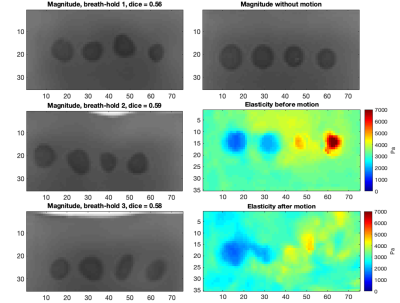Emily Chan1, Daniel Fovargue1, Matt Kelly2, Ralph Sinkus1,3, and Julia A Schnabel1
1School of Biomedical Engineering & Imaging Sciences, King's College London, London, United Kingdom, 2Perspectum, Oxford, United Kingdom, 3INSERM U1148, Laboratory for Vascular Translational Science, University Paris Diderot, University Paris 13, Paris, France
1School of Biomedical Engineering & Imaging Sciences, King's College London, London, United Kingdom, 2Perspectum, Oxford, United Kingdom, 3INSERM U1148, Laboratory for Vascular Translational Science, University Paris Diderot, University Paris 13, Paris, France
Care should be taken
to account for motion between breath-hold acquisitions in magnetic resonance
elastography.


